
Southern Praying Mantis Six Short Powers
Wushu KungFu, Winter 1995
Sifu Henry Poo Yee
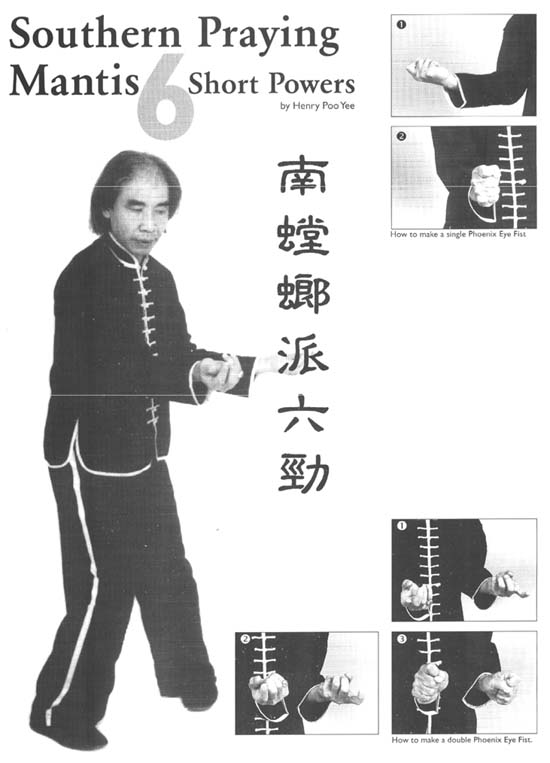 The root of the Southern Praying Mantis
kung fu style known as "Nan Tong Long Pai Lok Gang"
is the qigong (also called chi kung) of Gum Jong Jow - Tit Bo
Yee (hard chi kung of Golden Bell Iron Shirt). This produces the
system's short-range powers. The Southern Praying Mantis kung
fu system has six of this kind of short-range powers: guen-hon-dew
don gang, guen-hon-jet don gang, guen-hon-har gang, chung moon
gang, yuh moon gang, and jaw moon gang.
The root of the Southern Praying Mantis
kung fu style known as "Nan Tong Long Pai Lok Gang"
is the qigong (also called chi kung) of Gum Jong Jow - Tit Bo
Yee (hard chi kung of Golden Bell Iron Shirt). This produces the
system's short-range powers. The Southern Praying Mantis kung
fu system has six of this kind of short-range powers: guen-hon-dew
don gang, guen-hon-jet don gang, guen-hon-har gang, chung moon
gang, yuh moon gang, and jaw moon gang.
The short-range powers are only
developed by daily practice. The feet, the body, and the hands
must balance each other before you can have true strength. This
is especially true within the Jook Lum Temple style of Southern
Praying Mantis kung fu in the 18 Points Striking system. With
this short-range power training, a Southern Praying Mantis kung
fu practitioner produces yam yan - yul gon (yin and yang of opposite
strength) of kuen fat (hand movement abilities).
Using the Short Powers
For a skilled practitioner in a defense position, it is not necessary
to block an attacker's punch. Instead, the short-range powers
can be used initially to control the attacker's force. It is difficult
for a non-Southern Praying Mantis practitioner to understand this
kung fu fighting concept, but a skillful Southern Praying Mantis
practitioner, if attacked, won't block for defense, though he
will follow through with his own punch. As he completes the action,
he uses the following three motions: guen (contact); hon (using
and re-directing the incoming force); and don (then following
through with a punch). Within Southern Praying Mantis kung fu,
these motions are learned at various levels, including the short-range
powers in Nan Tong Long Pai Lok Gang; Som Dim Bum (Three and Half
Points Contact system); Ng Dim (Five Points system); and the Chut
Dim Lin Wan (Seven Points combination system). Combine kuen fat
with Nan Tong Long Pai Lok Gang, and you can achieve this defensive
strength in mobility.
Beginning Practice
There are several steps to practicing Nan Tong Long Pai Lok Gang
in the short-range powers of guen-hon-don gang.
First, position the Southern Praying
Mantis stance in the footwork of Ding Bud Ding, Bot Bud Bot. The
body posture should be in the shape of Dew Tung Dip Guat Show
Kay Bui, with the hands in the Southern Praying Mantis kung fu
fighting position of Tun Sao.
At this point, you must learn how
to form the kung fu style of Fun Non Choi (Phoenix Eye Fist).
To make a Jook Lum style of Phoenix Eye Fist, the footwork must
balance the upper body posture, with the two supporting each other
like a strut.
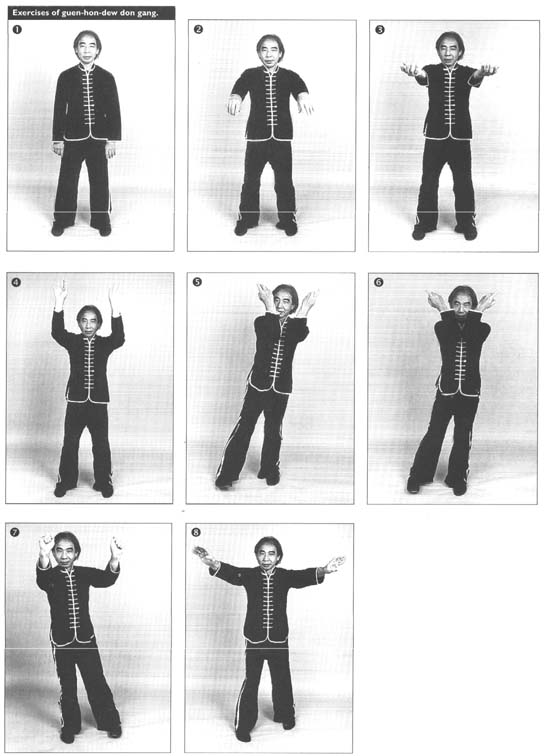 From the fighting position of Tun
Sao, slowly pull the body inward, curling in from the last fingers
on both hands. Slowly tighten up the body - except joints - with
tension as you would generate in motion. When both elbows are
curled in front of the body, make a reverse grip motion with both
hands in a Phoenix Eye Fist. Then release the grip's tension in
a controlled motion over a count of three.
From the fighting position of Tun
Sao, slowly pull the body inward, curling in from the last fingers
on both hands. Slowly tighten up the body - except joints - with
tension as you would generate in motion. When both elbows are
curled in front of the body, make a reverse grip motion with both
hands in a Phoenix Eye Fist. Then release the grip's tension in
a controlled motion over a count of three.
This kind of qigong from the body
produces the yam yan - yul gon powers. It should not be confused
with brute force. The short-range power of guen-hun-don gang is
generated from the body through controlled release. A truly traditional
Southern Praying Mantis kung fu practitioner must master the short-range
power of guen-hon-don gang - it is the base for strengths in the
mobility of balance with the system's yam yan - yul gon in kuen
fat. It is especially necessary within the system of Jook Lum
style of the Southern Praying Mantis kung fu of Mu Far Sop Bot
Dim Siem Kuen, a system of training under Jook Lum. This uses
the Phoenix Eye Fist like a hammer, striking into a human body's
pressure points or joints. Without this kind of guen-hon-don gang,
the kung fu's results will not be deadly.
Continued Exercise
Three exercises develop the short powers in guen-hon-don gang
for the Phoenix Eye Fist strikes.
The first exercise is called guen-hon-dew
don gang. It is also called dew (hanging) gang; bout (shoulder)
gang; or chang (long) gang.
Second are the guen-hon-jet don
gang. Jet, implying strength in the forward position, is also
called yul (waist) gang, or chung (middle) gang.
The last of the first three Nan
Tong Long Pai Lok Gang of guen-hon-har gang are called chum (sinking)
gang. These exercises develop control in footwork.
In Southern Praying Mantis kung
fu training, the three short powers of Nan Tong Long Pai Lok Gang
balance the training concepts regarding control with the strength
of the footwork. The body posture works within the system of kuen
fat to execute the Phoenix Eye Fist strikes.
The last three short powers of
Nan Tong Long Pai Lok Gang - hou som gang - combine the short
powers' concept of yam yan - yul gon to the kuen fat of open hands.
This is also called gee (finger) gang. It trains the practitioner
to "borrow" the opponent's force, and teaches techniques
such as the strike grip, pulling, hooking, trapping, pushing,
and thrashing.
Nan Tong Long Pai hou som gang
includes the positions of chung moon gang (center gate); yuh moon
gang (right gate); and jaw moon gang (left gate). To balance the
system's kuen fat in movements for all directions are the Nan
Tong Long Pai Lok Gang within the Jook Lum Temple Tong Long Pai
kung fu - som gen (three scissors) and say moon sao (four gate).
About the Author: Henry Poo Yee
is a fifth generation direct disciple of the late fourth generatiion
Grandmaster Sifu Lam Sang, of Jook Lum Temple Tong Long Pai. Sifu
Yee is the director and head instructor of the Chinese Kung Fu
Academy of Southern Praying Mantis Federation, U.S.A. headquarters,
at Houston, Texas.
home
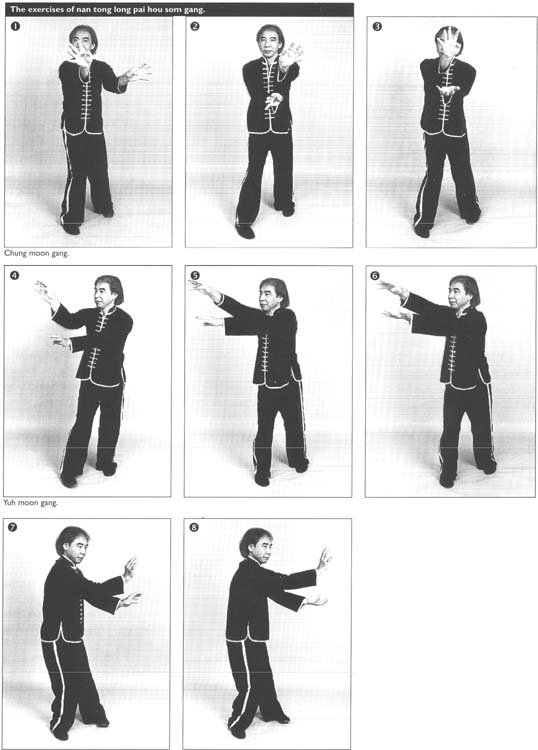
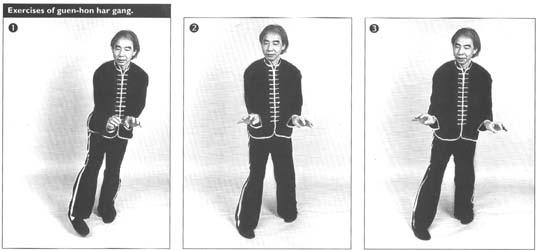
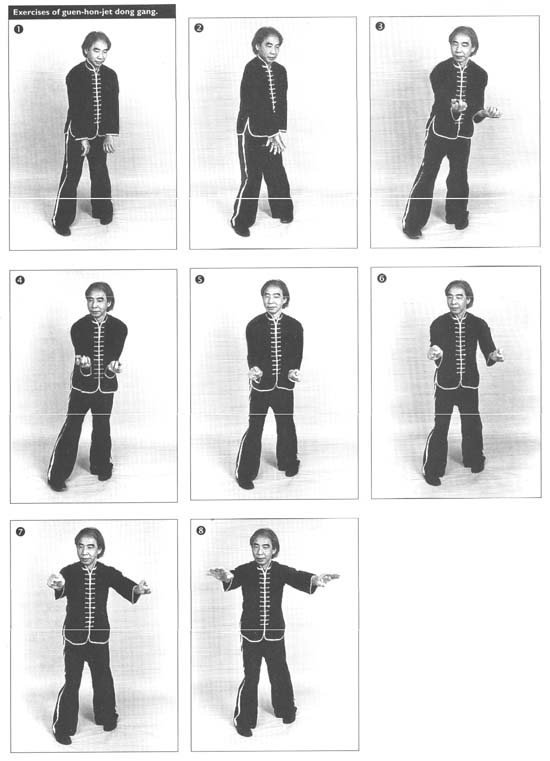

 The root of the Southern Praying Mantis
kung fu style known as "Nan Tong Long Pai Lok Gang"
is the qigong (also called chi kung) of Gum Jong Jow - Tit Bo
Yee (hard chi kung of Golden Bell Iron Shirt). This produces the
system's short-range powers. The Southern Praying Mantis kung
fu system has six of this kind of short-range powers: guen-hon-dew
don gang, guen-hon-jet don gang, guen-hon-har gang, chung moon
gang, yuh moon gang, and jaw moon gang.
The root of the Southern Praying Mantis
kung fu style known as "Nan Tong Long Pai Lok Gang"
is the qigong (also called chi kung) of Gum Jong Jow - Tit Bo
Yee (hard chi kung of Golden Bell Iron Shirt). This produces the
system's short-range powers. The Southern Praying Mantis kung
fu system has six of this kind of short-range powers: guen-hon-dew
don gang, guen-hon-jet don gang, guen-hon-har gang, chung moon
gang, yuh moon gang, and jaw moon gang. From the fighting position of Tun
Sao, slowly pull the body inward, curling in from the last fingers
on both hands. Slowly tighten up the body - except joints - with
tension as you would generate in motion. When both elbows are
curled in front of the body, make a reverse grip motion with both
hands in a Phoenix Eye Fist. Then release the grip's tension in
a controlled motion over a count of three.
From the fighting position of Tun
Sao, slowly pull the body inward, curling in from the last fingers
on both hands. Slowly tighten up the body - except joints - with
tension as you would generate in motion. When both elbows are
curled in front of the body, make a reverse grip motion with both
hands in a Phoenix Eye Fist. Then release the grip's tension in
a controlled motion over a count of three.

